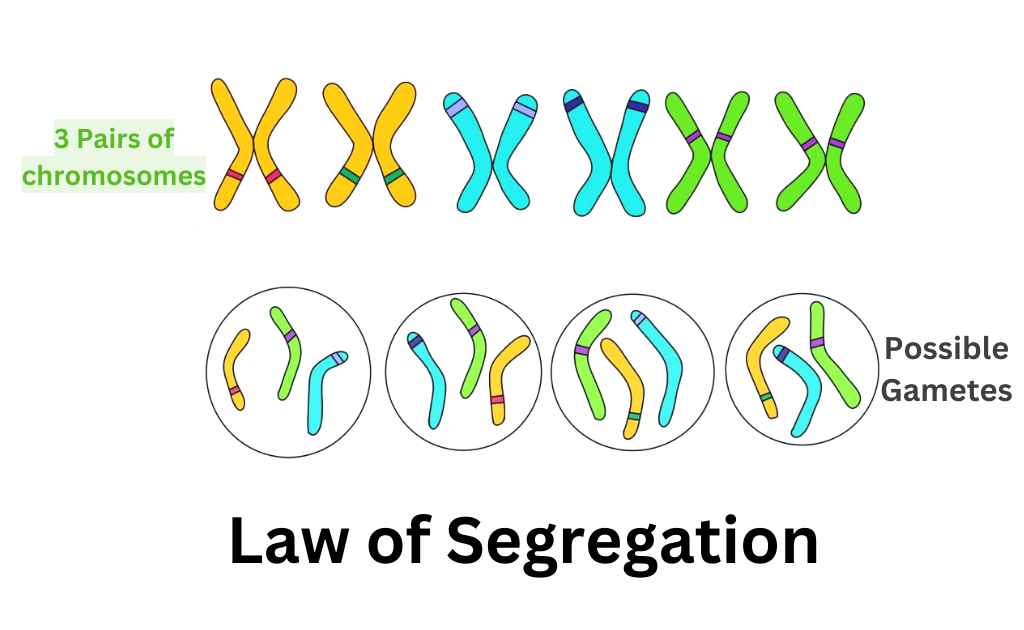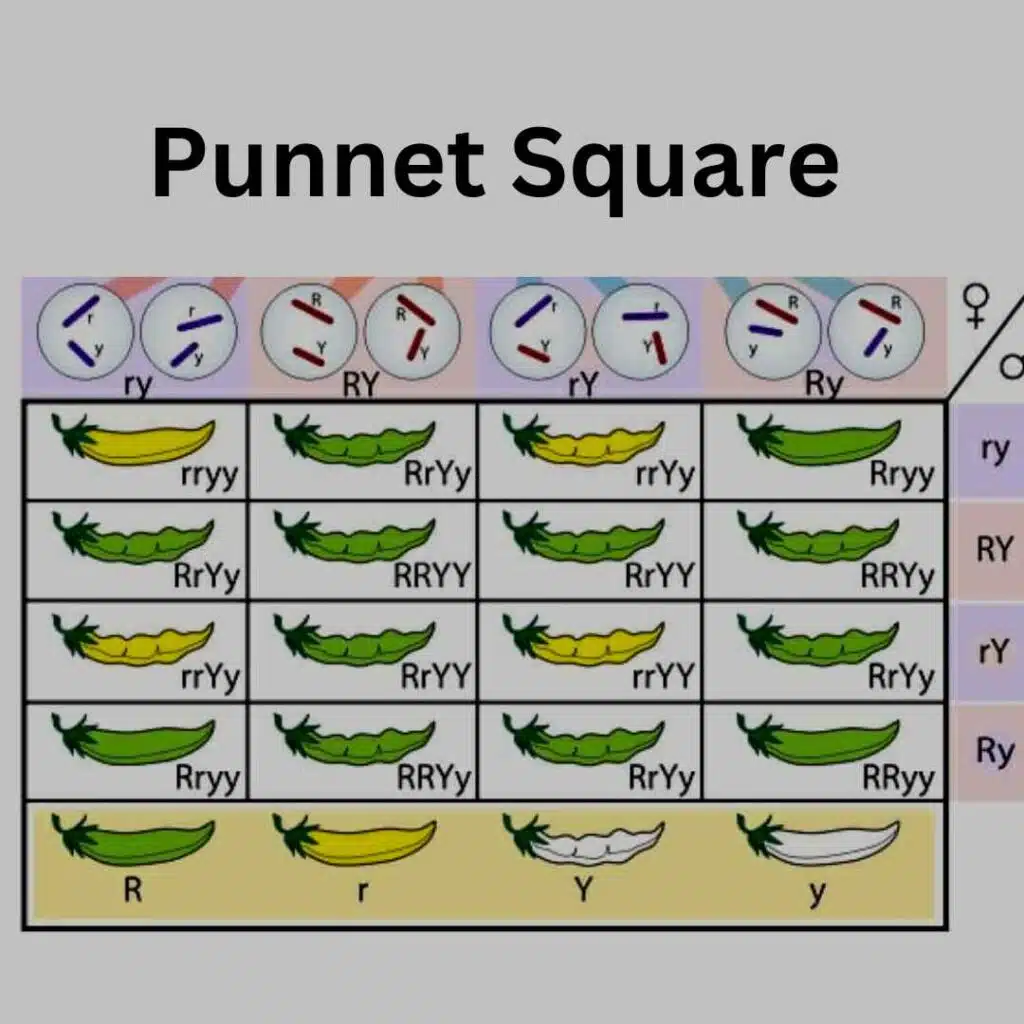Law of Segregation | Law of Inheritance
The law of segregation is a fundamental principle of genetics that explains how traits are passed down from one generation to the next, and it has been confirmed by numerous experiments and observations.
The cellular basis of Mendel’s law of segregation is the separation of homologous chromosomes during meiosis.
The Law of Segregation was the second law of Inheritance. It states that
”Two coexisting alleles for each trait in an individual segregate from each other during meiosis and each gamete receives only one of both alleles. Alleles unite again at random fertilization of gametes during zygote Formation”.

The law of segregation tells us that the rearrangement of chromosomes into gametes is a random process. Each gamete receives only one allele from each parent for a particular trait. It ensures that the offspring inherit two alleles for each trait, one from each parent. So the resulting genotypic ratio follows the 1:2:1 pattern.
For Mendel’s law of segregation to occur, the alleles must be located on homologous chromosomes, which are paired chromosomes that are similar in size and shape and carry genes for the same traits.
Law of Segregation and Its Relationship to Meiosis
The law of segregation and meiosis are closely related. Meiosis is the process by which gametes are formed, and the law of segregation states that alleles for a trait separate during gamete formation. It ensures that each gamete receives only one allele from each parent, allowing for the predictable inheritance of traits from parents to offspring.
Proof of Law of segregation by Monohybrid cross
Mendel carried out the following crosses to prove this law:
F1 Cross: Mendel crossed the two P1 generations. One was dominant with round seeds and the other was recessive with wrinkle seeds. All the offspring in F1 were round seeds.
F2 Cross: Then Mendel allowed self-fertilization among F1 monohybrids. It produces F2 progeny. 3/2 % of F₂ were round and 1/4 were wrinkled. Mendel got a 3:1 ratio in offspring of monohybrid crosses for all the seven contrasting pairs of traits.
F3 cross: Then Mendel self- fertilized F₂ plants and got F3 generation. He noted that. 1/3 % of the F2 round produced only round. But 2/3 of F round produced both round and wrinkled and gave a 3:1 ratio. But F₂ wrinkled produced only wrinkled. He concluded that 1/3 of F3 rounds were true-breeding like the P1 round, and 2/3 of R rounds were monohybrids like the F2 round.
Mendel’s Interpretation
Mendel gave concept of hereditary factor that was responsible of transfer of traits from parents to offspring.
Concept Of Hereditary Factor
Mendel proposed that each contrasting firm of the trait was determined by particulate hereditary factors. He called these hereditary factors elementen (allele). For example, roundness or wrinkledness of seed. These factors carry hereditary information.
Hereditary information is transmitted from parents to offspring through gametes. Each pea plant had a pair of these factors (allele). One allele is derived from a male parent and the other from a female parent. Both of these factors together control the expression of a trait.
He designated the dominant factor with a capital letter and the recessive factor with a small letter. e.g. R for roundness factor and r for wrinkledness factor. Johansen named these factors genes.
Types Of Organisms Based On The Nature Of Alleles
There are two types of organisms based on the nature of alleles.
Homozygous
When both the alleles of a gene pair in an organism are the same, it is called homozygous. An individual with a homozygous genotype is homozygote. The true-breeding round seed plant of the P1 generation carried R alleles. But the true-breeding wrinkled seed plant of P1 carried ‘rr’ alleles. So the organism is homozygous for that gene pair.
Heterozygous
When both the alleles of a gene pair in an organism are different, it is called heterozygous. An individual with a heterozygous genotype is a heterozygote. For example Rr.
F1 And F2 Crosses in Law of Segregation
F1 Cross: Mendel concluded that the factors of a pair (alleles) separated from each other during gamete formation. Thus each gamete got only one factor (allele) for each trait. So half the gametes got one allele, and the other half carried the other allele.
Fertilization is random. The male gamete with factor (R) fertilized the female gamete with factor (r) and the zygote is formed. The zygote has a complete set of the two factors (Rr) for the trait. The zygote developed into F1 offspring. The offspring was heterozygous Rr.
Thus the F1 offspring was a rounded seed phenotype. But it is heterozygous in the genotype. Its alleles are also segregated during gamete formation.
F2 cross: Punnett square indicates that ¼ % of F₂ progeny have ‘RR’ (homozygous round), ¼ + ¼ = ½ Rr (heterozygous round), and ¼ rr (wrinkled). Mendel observed a 3:1 phenotypic ratio in F2. But its genotypic ratio was 1:2:1 genotypic in F2.
Mendel separately studied all seven characters and compared their result He found similar results. It proved the law of segregation.

Frequently Asked Questions
What is the difference between the law of independent assortment and the law of segregation?
The law of segregation states that pairs of alleles for a trait separate during the formation of gametes, while the law of independent assortment states that the inheritance of one trait is independent of the inheritance of another trait.
Which statement summarizes the law of segregation?
The law of segregation is summarized by the statement that each gamete receives only one allele from each parent for a given trait.
Which scenario breaks the law of segregation?
The scenario where a gamete receives two alleles for a given trait from one parent breaks the law of segregation.
The law of segregation predicts which phenomenon during gamete formation?
The law of segregation predicts the separation of homologous chromosomes during meiosis, resulting in the distribution of one allele for each trait into each gamete.
What observable cellular process explains Mendel’s law of segregation?
Mendel’s law of segregation can be explained by the observable cellular process of the separation of homologous chromosomes during meiosis.
Which meiotic process results in the law of segregation?
The meiotic process of the separation of homologous chromosomes in the first meiotic division, known as meiosis I, results in the law of segregation.







Leave a Reply